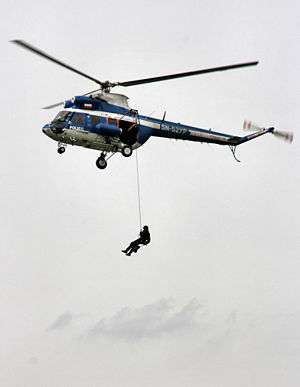PZL Kania
| PZL Kania | |
|---|---|
 | |
| PZL Kania of Polish Police | |
| Role | Helicopter |
| Manufacturer | PZL-Świdnik |
| First flight | 3 June 1979 |
| Primary user | Poland |
| Produced | 1986-2006 |
| Number built | 19 |
| Developed from | Mil Mi-2 |
The PZL Kania (Polish Kite, also marketed as Kitty Hawk) is a follow-up to the Mil Mi-2 helicopter, developed in Poland by PZL-Świdnik.
Design and development
In 1964, an agreement was signed between Poland and the Soviet Union assigning production of the Mil Mi-2 twin-engined light helicopter exclusively to the WSK PZL-Świdnik factory at Świdnik, Poland.[1]
Work on a significantly redesigned version of the Mi-2 started in 1977.[2] PZL decided to develop, in conjunction with the American aero-engine company Allison, a re-engined version for export for western markets, the Kania or Kitty Hawk.[3] The changes include a modified fuselage with more pointed nose, new engines (Allison 250-C20B turboshaft engines) each rated at 426 hp (313 kW), new composite rotors blades, and new western avionics. The first prototype, utilizing a modified Mi-2 airframe, was flown on 3 June 1979.[4] Two prototypes were made and two pre-series machines. Tests conducted during the early 1980s led to certification according to FAR-29, in February 1986.[2]
The prototype SP-SSC took part in the 5th Helicopter World Championships in Castle Ashby in 1986.[2] A production started that year in small numbers, in the PZL Świdnik factory. The helicopter was to be a replacement of the Mi-2, more economical, comfortable and offering better performance, and it compared quite favourably with Western counterparts. It did not become popular, however, partly due to problems with certification and a weak promotion in Western countries, and reluctance to spend convertible currency for imported parts in Eastern Bloc countries in the 1980s. Only 19 were built until 2006, including prototypes.[5] It isn't currently in PZL-Świdnik's offer anymore.[6]
Main user is the Polish Border Guard, using 7 helicopters (not at one time). Polish Police uses two helicopters.[5] Three Polish Kanias were employed in air service in Sierra Leone in 1987-1990.[7] In 2007, Świdnik offered 6 armed Kanias for Philippine Air Force, but lost in competition[8] (finally, after cancelling a procedure, PZL W-3 Sokół was chosen).
Variants
- Passenger Standard
- Seats for pilot and 9 passengers, individual vents and lighting.
- Passenger Executive
- Seats for pilot and 5 passengers, luxury finishing, silenced cockpit, individual vents, lighting and audio system.
- Cargo
- Ability to carry external loads as a flying crane or to carry up to 1200 kg of load in the cabin.
- Medevac / Air ambulance
- Equipment and space for up to 4 stretchers or less with paramedic crew on board.
- Agricultural
- Ability to carry up to 1000 kg of chemicals or agro loads (grains, seeds etc.) and ability to carry on one of following aerial application methods: LV spraying, ULV spraying, dustring and spreading (not built in series, only tested).
- Spitfire Taurus II or Super Kania
- American version of the PZL Kania, with redesigned fuselage and single Allison 250-C28 550 HP engine, with a big central air inlet, that was to be built under licence in the United States by Spitfire Helicopters but only a mock-up was built.[8]
Operators
 Cyprus (2 in National Guard, from 1990)[5]
Cyprus (2 in National Guard, from 1990)[5] Czech Republic (4 from 1992 - former)[5]
Czech Republic (4 from 1992 - former)[5] Poland (some are in use in Policja and Straż Graniczna)
Poland (some are in use in Policja and Straż Graniczna) Sierra Leone (3 from 1987-1990 - former)
Sierra Leone (3 from 1987-1990 - former) Slovakia (1 from 1994)[5]
Slovakia (1 from 1994)[5] Venezuela (1 in 1989-1996 - former)[5]
Venezuela (1 in 1989-1996 - former)[5]
Specifications
Data from Jane's All The World's Aircraft 1988-89 [9]
General characteristics
- Crew: One
- Capacity: 9 passengers or 1,200 kg (2,645 lb) internal, 800 kg (1,763 lb) external cargo
- Length: 12.03 m (39 ft 5½ in)
- Rotor diameter: 14.56 m (47 ft 9¼ in)
- Height: 3.75 m (12 ft 3½ in)
- Disc area: 167 m² (1,792 ft²)
- Empty weight: 2,000 kg (4,409 lb)
- Max. takeoff weight: 3,550 kg (7,826 lb)
- Powerplant: 2 × Allison 250-C20B turboshafts, 313 kW (420shp) each
Performance
- Maximum speed: 215 km/h (116 knots, 134 mph)
- Cruise speed: 190 km/h (102 knots, 118 mph) (econ cruise)
- Range: 493 km (266 nmi, 306 mi) (standard fuel, no reserves)
- Ferry range: 863 km (466 nmi, 536 mi) (max fuel, no reserves)
- Service ceiling: 4,000 m (13,120 ft)
- Hovering ceiling: 1,375 m (4,510 ft) out of ground effect
- Rate of climb: 8.75 m/s (1,725 ft/min)
See also
- Related development
References
- ↑ Taylor 1982, p.169.
- 1 2 3 Miłosz Bogdański: Kania uczy się latać (Kania learns to fly) in: Aeroplan Nr. 5-6(80-81)/2009, pp.4-16 (Polish)
- ↑ Taylor 1982, p.170.
- ↑ Taylor 1988, p.188.
- 1 2 3 4 5 6 Lista produkcyjna śmigłowców Kania (Kania production list) in: Aeroplan Nr. 5-6(80-81)/2009, p.46 (Polish)
- ↑ Official PZL-Swidnik page [retrieved 11-3-2011]
- ↑ Miłosz Bogdański: Kania w służbie (Kania in service) in: Aeroplan Nr. 5-6(80-81)/2009, pp.24-32 (Polish)
- 1 2 Miłosz Bogdański: Niezrealizowane projekty i nieudany eksport in: Aeroplan Nr. 5-6(80-81)/2009, p.17-23 (Polish)
- ↑ Taylor 1988, p.189.
- Taylor, John W R (ed). Jane's All The World's Aircraft 1982-83. London:Jane's Yearbooks, 1982. ISBN 0-7106-0748-2.
- Taylor, John W R (ed). Jane's All The World's Aircraft 1988-89. Coulsdon, UK:Jane's Defence Data, 1988. ISBN 0-7106-0867-5.
| Wikimedia Commons has media related to PZL Kania. |
- PZL Kania, Aeroplan Nr. 5-6(80-81)/2009 (special issue) (Polish)